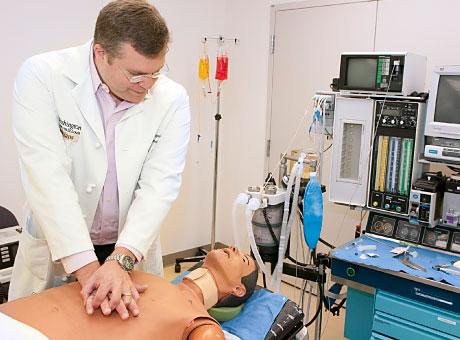
Peter Nagele, MD, demonstrates chest compression-only CPR on a mannequin in the School of Medicine's Clinical Simulation Center.

Peter Nagele, MD, demonstrates chest compression-only CPR on a mannequin in the School of Medicine's Clinical Simulation Center.
Heart attack patients whose hearts have stopped beating and who receive cardiopulmonary resuscitation (CPR) from bystanders fare better if resuscitators skip the rescue breaths and do only chest compression, says a study led by School of Medicine researchers.
Published online Oct. 15, 2010, in The Lancet, the study determined that the chest compression-only method of CPR improved survival rates over standard CPR, which involves alternating chest compressions with rescue breaths.
“We looked at data from three studies,” says principal investigator Peter Nagele, MD. “Individually, the studies were ‘underpowered’ statistically and could not show a survival benefit. But when we combined all three studies, there was a significant increase in survival when witnesses were told by 911 dispatchers to provide chest compression only.”
Nagele, assistant professor of anesthesiology and chief of trauma anesthesiology at Barnes-Jewish Hospital, and his team combined data from the three studies in a meta-analysis and were able to analyze survival rates in more than 3,700 cardiac arrest patients.
The research team, which included investigators from the Medical University of Vienna in Austria, determined that survival improved by 22 percent when bystanders called 911 and were advised by the dispatcher to do chest compression-only CPR.
“When a person goes into cardiac arrest because of a problem with the heart, that individual normally has plenty of oxygen in the body,” Nagele explains. “So rescue breaths aren’t as vital to survival as trying to keep blood flowing as regularly as possible. However, if cardiac arrest is secondary to trauma, drowning or a problem not directly related to heart function, then it is advisable to do standard CPR that includes rescue breaths. In those cases, getting oxygen into the system is crucial.”
Nagele stresses that the findings apply only to adults. In children, he explains, cardiac arrest is likely to be secondary to a severe asthma attack, an allergic reaction or something else unrelated to the heart. Under those circumstances, the body needs oxygen.
“The heart doesn’t literally stop during cardiac arrest,” Nagele says. “It gets superexcited and electrically very active, and the only way to get it back into rhythm is with an electrical shock, a defibrillation. By doing chest compression-only CPR, a bystander is basically buying time until a paramedic with a defibrillator can jump-start the heart.”